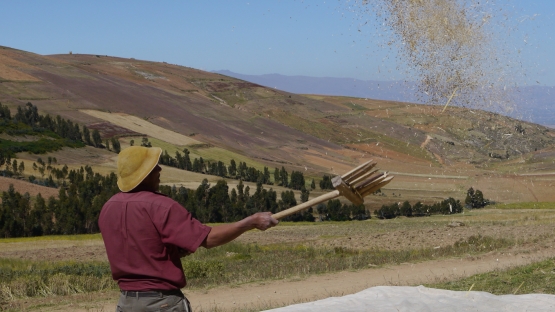Marino Romero died in 2005, but his work was continued by his wife, Professor Luz Gomez Pando, who since 1998 has led the Cereal Research Programme at La Molina University.
“Before the intervention of my late husband, barley was largely ignored by plant breeders and researchers since it was associated mainly with beer and animal feed,” she says.
“They didn’t realise that after potatoes it was the second most important source of food for poor communities.”
By cultivating the higher-yielding, improved varieties, farmers have seen an increase from 800 kilos of grain per hectare to 3000 kilos and a two-fold increase in protein content from seven to fourteen per cent.
Two of the most successful barley types were developed using a nuclear technique known as ‘radiation induced mutation’.
With this method, breeders use radiation on seeds to induce changes in plants. This speeds up a process that would normally take place under naturally occurring radiation.
“Radiation brings about changes,” says Gomez Pando, adding: “These could be big or small, negative or positive. We’re not adding anything to the plant, rather copying what happens in nature, but can take thousands or millions of years.”
After seeds have been irradiated they are planted at experimental sites and monitored carefully by the breeders.
The seeds of the promising plants are harvested and replanted and this selection process continues for up to seven years, to identify the best improved types in field and laboratory conditions.
Once an improved line has been identified, tested and officially confirmed, it is released as a new variety.
In 2006, La Molina released its latest barley ‘Centenario’, which was developed using the irradiation breeding technique and is proving to be the best so far.
Professor Gomez Pando says: “It has more protein than other varieties and a higher yield. It’s resistant to yellow rust, tolerant to frost and due to its included head does not get damaged by hail.”
Thanks to Centenario, Andean farmers now produce enough grain to meet their personal needs and have a surplus to sell.
In the village of Conopa, farmer Erwin Ortega says: “Compared to all other types of barley, Centenario is the best, because it has more grains and they’re heavier. It also tastes better and it’s important for the development of our children.”
Centenario fetches twice the price of other barley varieties. In fact, it is so popular and abundant that the farmers want to expand their markets.
Erwin’s brother, Armando, says: “We need to find new markets that will pay us the right price for this type of organic barley, perhaps in other parts of Peru or overseas. Now we sell barley to middlemen at a low price.”
The work of Professor Gomez Pando is being supported by the Peruvian branch of the organisation Caritas. Together they distribute Centenario seeds to the farmers and help them find ways to sell their grains.
“When we started to support the farmers, by giving them the seeds and technical assistance, their production tripled,” says Juan Pio Silva, head of Economic and Production Development at Caritas Peru.
“So there was a great supply of barley, but the market was not able to absorb it directly as grain. We then found the alternative of processing barley into flour and this opened new commercial channels for the farmers.”
Caritas has set up a chain of small processing plants in the Andes where farmers can work in a collective initiative to process the barley into flour and other cereal products that are sold to outlets in Lima and other parts of Peru.
“There is a lot of poverty in Peru,” says Silva, “but it’s higher in the rural areas, especially in the High Andes. I think that the best way to support the people there is by developing the crops they’ve always harvested, such as barley.”
Following the success of Centenario barley, the breeders at La Molina University turned their attention to another Andean plant, kiwicha, a kind of amaranth.
Using radiation induced mutation, they have developed a variety, known as Centenario-Kiwicha, that has a better nutritional value and higher yield than other varieties.
Kiwicha was a staple food in the diet of the ancient Incas. It has 30 per cent more protein than common cereals, such as rice and wheat, and is high in dietary fibre and minerals such as iron and magnesium.
Kiwicha is not as common as barley in the Andes or as easy to grow, but it enjoys the export potential that barley currently lacks.
There is a high demand for exports of Centenario-Kiwicha to countries like Japan and the USA, since this is an organic, high-quality product.
One of Peru’s main exporters of Andean grains is Lima-based, Interamsa Agroindustrial.
The company’s General Manager, Gustavo Pereda, saw the potential of Centenario-Kiwicha and has developed a business strategy that is benefiting both the farmers and his company.
“In 2002, I started cooperating with Professor Gomez Pando. She gave me Centenario-Kiwicha seeds. I went to the farmers in the Andes and asked them to plant them with the promise that I would buy the grain at harvest time.”
Impressed with the quality of the kiwicha, the cooperation progressed and now Interamsa Agroindustrial buys the seeds from La Molina and the farmers cultivate the kiwicha.
“I give the farmers the seeds, they do the work and when they harvest I pay a fair market price for the grain.”
He added that when the business deal goes well, he invests further in the farmers and provides them with new equipment.
“The market for kiwicha is growing every year. I sell it to the USA and Japan and am hoping to sell in Europe too,” says Pereda.





